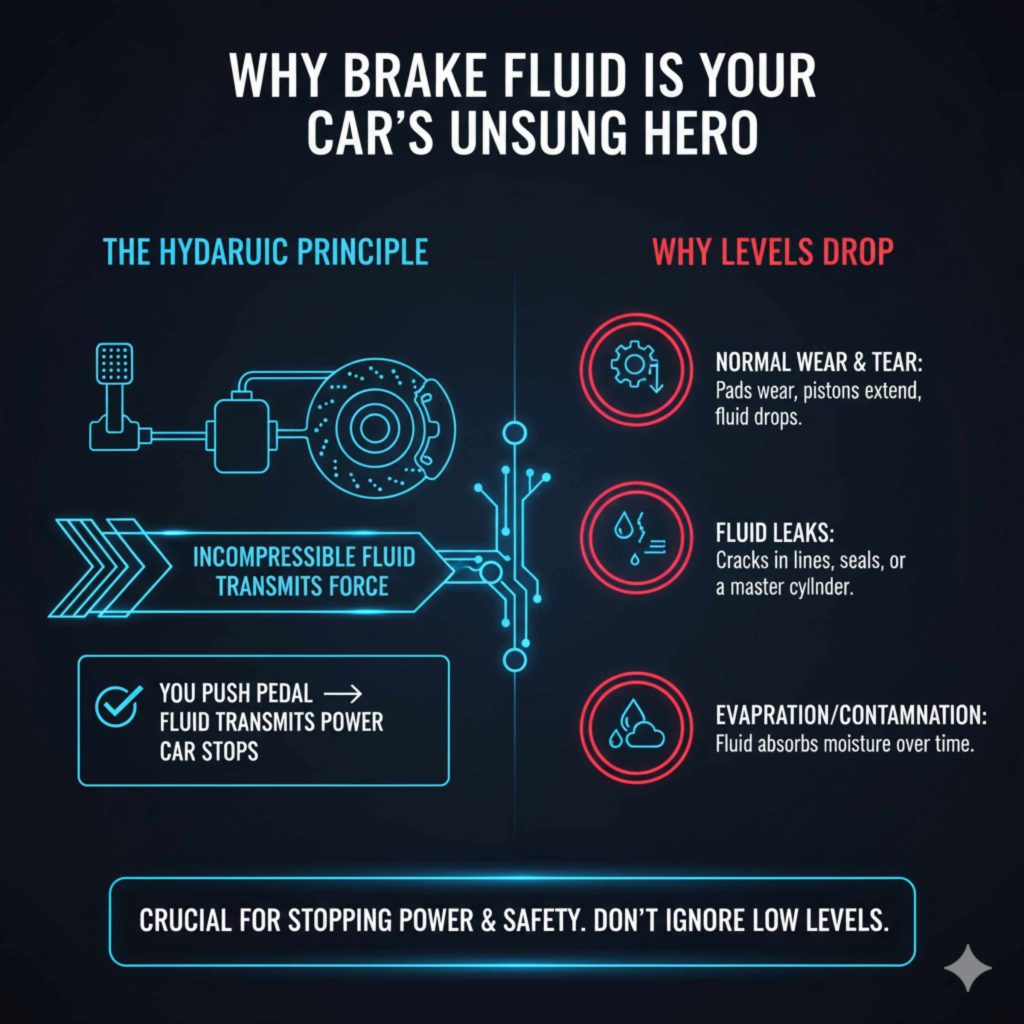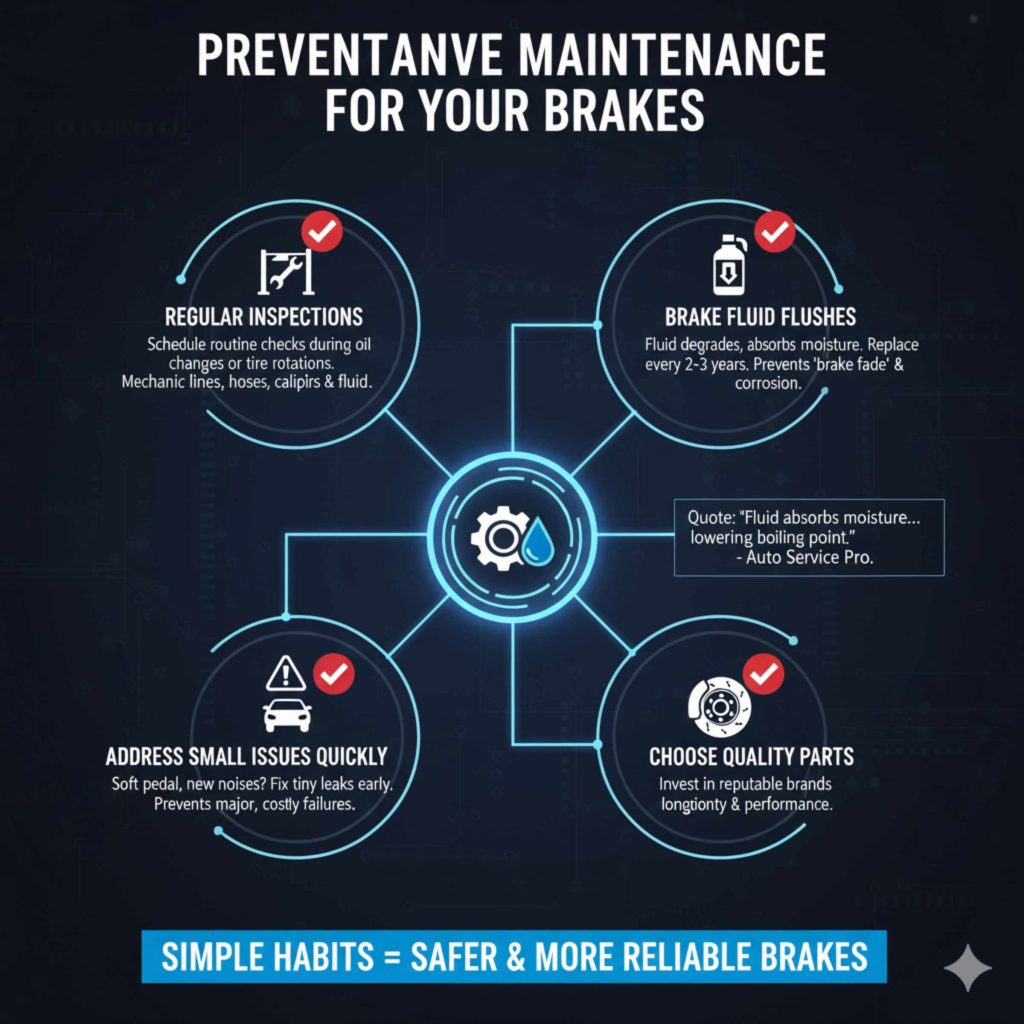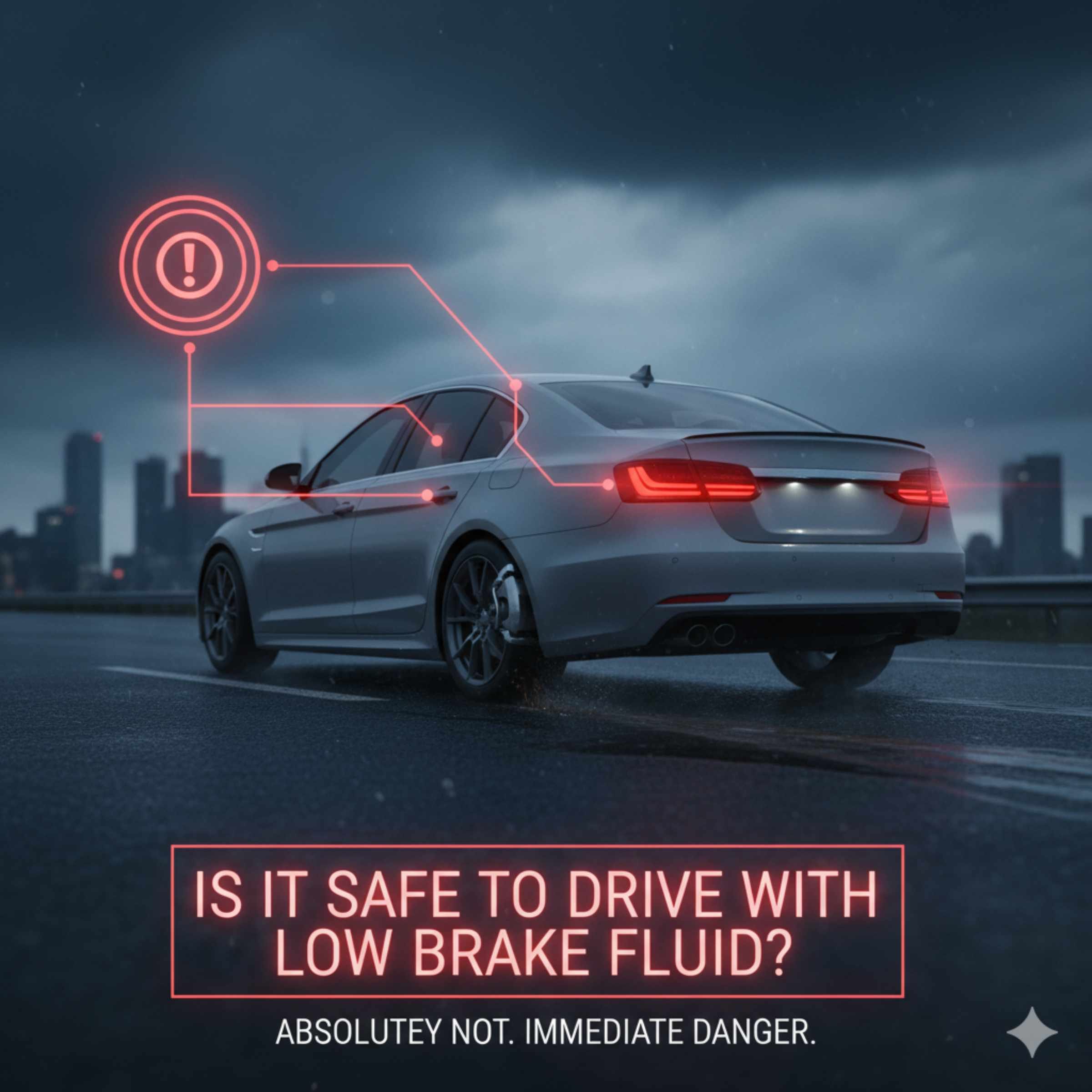Driving with low brake fluid is extremely dangerous, significantly reducing your braking power and increasing the risk of accidents. It’s crucial to address this issue immediately for your safety and the safety of others. This guide will help you understand why and what to do.
Ever noticed your car’s brake pedal feeling spongy, sinking closer to the floor, or maybe you’ve seen a warning light flash on your dashboard? These can be signs that your brake fluid is low. It’s a common worry for many drivers, and understandably so – brakes are pretty important! If you’re wondering, “Is it safe to drive my car with low brake fluid?” the straightforward answer is no, it’s not. Driving with insufficient brake fluid seriously compromises your ability to stop quickly and safely. But don’t panic! We’re here to break down exactly why this happens, what those symptoms mean, and how you can safely get your car back to its best. Let’s dive in and make car care feel less like a mystery and more like a manageable task.
Why Brake Fluid is Your Car’s Unsung Hero
Think of your brake fluid like the lifeblood of your braking system. When you press the brake pedal, you’re not directly pushing the brake pads against the rotors. Instead, you’re pushing on a fluid that transmits that force through a network of lines to the brakes at each wheel. This is called hydraulic pressure, and it’s incredibly efficient at stopping your car. Brake fluid is designed to be incompressible, meaning it doesn’t squeeze into a smaller volume when pressure is applied. This allows the pressure from your foot on the pedal to be transmitted directly and powerfully to the braking components.
There are several reasons why brake fluid levels might drop:
- Normal Wear and Tear: As your brake pads wear down over time, the pistons in the brake calipers have to extend further to apply pressure. This means the brake fluid reservoir level naturally drops slightly. It’s a gradual process, and very small drops are normal.
- Fluid Leaks: This is the more critical reason. If your brake fluid level is dropping rapidly, it almost always indicates a leak somewhere in the brake system. This could be a tiny crack in a brake line, a faulty seal in a caliper or wheel cylinder, or a problem with the master cylinder.
- Evaporation/Contamination: While less common for significant drops, brake fluid can absorb moisture over time. This can lead to corrosion, which might cause small leaks.

Warning Signs: How to Tell if Your Brake Fluid is Low
Your car is pretty good at letting you know when something’s up, and your braking system is no exception. Pay attention to these common signs that indicate low brake fluid, which means reduced braking performance:
- Spongy or Soft Brake Pedal: This is perhaps the most common and unnerving sign. When you press the brake pedal, it feels mushy or sinks further towards the floor than usual. This happens because there’s air or insufficient fluid to create the necessary hydraulic pressure.
- The Brake Warning Light Illuminates: Most modern cars have a brake warning light on the dashboard. This light can illuminate for several reasons, including low brake fluid level and/or the parking brake being engaged. If it’s on and your parking brake isn’t engaged, low fluid is a likely culprit.
- Squealing or Grinding Noises: While these sounds can indicate worn brake pads, they can also occur if the braking system isn’t getting enough fluid pressure. The system might be struggling to work effectively.
- Vehicle Pulling to One Side: If one brake caliper isn’t receiving adequate fluid pressure due to a leak or blockage, it won’t engage as strongly as the others. This can cause your car to pull to the side when you brake.
- Reduced Braking Power: The most direct consequence. You’ll notice it takes longer to stop your car, or you have to press the brake pedal much harder to achieve the same stopping effect.
These signs aren’t just minor inconveniences; they are direct indicators of a compromised safety system. Ignoring them is a significant risk.
Is It Safe to Drive Car With Low Brake Fluid? The Definitive Answer
Let’s be perfectly clear: No, it is NOT safe to drive a car with significantly low brake fluid. Your brake system relies on that fluid under pressure to function. When the fluid level drops too low, two main things happen:
- Air Enters the System: If the fluid level goes below the opening for the brake lines in the master cylinder reservoir, air can be drawn into the system. Air, unlike brake fluid, is compressible. When you press the brake pedal, instead of transmitting force, the air will be compressed, leading to that spongy pedal feel and drastically reduced braking effectiveness.
- Reduced Hydraulic Pressure: Even without air entering the system, simply having less fluid means there’s less substance to transmit the hydraulic pressure. This results in weaker braking force.
Imagine trying to push a strong gust of wind with your hand versus pushing a solid object. The fluid is the solid object; air is the wind. You need that solid, incompressible fluid to make your brakes work. Driving with low brake fluid is essentially like driving with faulty brakes, significantly increasing your stopping distance and the probability of an accident, especially in emergency situations.
What To Do If Your Brake Fluid is Low
If you suspect your brake fluid is low, or you’re experiencing any of the warning signs, here’s how to approach it:
Step 1: Check the Brake Fluid Level
This is a simple check most drivers can perform. Locate your brake fluid reservoir. It’s usually a small, translucent plastic tank near the back of the engine bay on the driver’s side. You’ll typically see “MIN” and “MAX” lines marked on the side of the reservoir. If the fluid level is below the “MIN” line, it’s low and needs attention.
Important Note: Never rely solely on the brake light. Always visually inspect the reservoir.
Step 2: Identify the Cause (Crucial!)
As we discussed, low brake fluid is rarely just a “low” problem; it’s usually a symptom of something else. If the fluid is just slightly below the “MIN” line due to normal pad wear, you might be able to top it up. However, if it’s significantly low, or has dropped suddenly, it almost certainly means there’s a leak.
DO NOT just top up a leaking system and assume it’s fixed. You absolutely need to find and repair the leak. Driving with a leaking brake system is incredibly dangerous.
Step 3: Topping Up (Temporary Measure for Minor Drops Only)
If the fluid is only slightly low, and you’ve confirmed no obvious dripping or leaks, you can add the correct type of brake fluid. It’s vital to use the type recommended in your car’s owner’s manual—most commonly DOT 3 or DOT 4. Using the wrong type can damage your brake system.
This is a temporary fix. If the level drops again, or if you suspect a leak, get it checked by a professional immediately.
Here’s a basic rundown of topping up:
- Ensure the engine is off and the car is on a level surface.
- Locate the brake fluid reservoir.
- Open the cap carefully. Be mindful of any dirt or debris that could fall into the reservoir; you can wipe around the cap first.
- Using a clean funnel, slowly add the correct type of brake fluid until it reaches the “MAX” line. Do not overfill.
- Replace the cap securely.
Step 4: Seeking Professional Help (The Safest and Smartest Option)
If your brake fluid is significantly low, there’s a suspected leak, or you’re uncomfortable performing the check yourself, it’s time to call a qualified mechanic. They have the tools and expertise to:
- Diagnose the exact cause of the low fluid (leaking lines, faulty caliper, master cylinder issues, etc.).
- Repair the leak.
- Bleed the brake system to remove any air that may have entered.
- Ensure the new fluid is properly filled and that the system is functioning correctly.
For information on maintaining your vehicle’s safety systems, the National Highway Traffic Safety Administration (NHTSA) offers valuable resources.
Some common repair scenarios include:
- Brake Line Replacement: If a metal or rubber brake line has corroded or cracked.
- Brake Caliper/Wheel Cylinder Repair or Replacement: Seals in these components can fail, leading to leaks.
- Master Cylinder Rebuild or Replacement: The master cylinder is the heart of the hydraulic system.
Brake Fluid Types: Don’t Mix Them Up!
Brake fluid isn’t one-size-fits-all. Using the wrong type can cause serious damage to your brake system components because materials and performance characteristics differ. Always refer to your vehicle’s owner’s manual. The most common types are:
| Type | Key Characteristics | Common Uses | Notes |
|---|---|---|---|
| DOT 3 | Glycol-based, good boiling point, absorbs moisture. | Most older and many newer mainstream vehicles. | Requires regular flushing due to moisture absorption. |
| DOT 4 | Glycol-based, higher boiling point than DOT 3, absorbs moisture. | Performance vehicles, many modern cars. | Offers better heat resistance, especially important for heavy braking. |
| DOT 5 | Silicone-based, does NOT absorb water, higher boiling point. | Some older military vehicles, classic cars where water absorption is a concern. | DO NOT mix with DOT 3 or 4. Requires special bleeding procedures. Not compatible with most modern systems. |
| DOT 5.1 | Glycol-based (despite the ‘5’), higher boiling point than DOT 4. | High-performance vehicles, racing applications. | Offers excellent performance but still absorbs moisture like DOT 3 and 4. |
Rule of thumb: DOT 3 and DOT 4 are generally interchangeable IF your manual specifies one or the other. DOT 5 is completely different and should not be mixed with glycol-based fluids. DOT 5.1 is a high-performance glycol-based fluid.
Preventative Maintenance for Your Brakes
The best way to avoid the dangers and stresses of low brake fluid is through regular maintenance. This ensures your braking system is always in top condition.
Regular Inspections
Schedule routine checks of your braking system as part of your car’s maintenance. This usually happens during oil changes or tire rotations. A mechanic will visually inspect brake lines, hoses, calipers, and fluid levels.
Brake Fluid Flushes
Brake fluid degrades over time, especially DOT 3 and DOT 4 types, as they absorb moisture. This absorbed water lowers the boiling point of the fluid. When your brakes get hot (like during heavy braking), this water can turn into steam, creating compressible pockets in the fluid, much like air. This is known as “brake fade” and severely reduces stopping power. Most manufacturers recommend flushing and replacing brake fluid every 2-3 years, regardless of mileage. Your owner’s manual will have the specific recommendation for your vehicle. A fluid flush involves draining the old fluid and refilling with fresh fluid.
According to Auto Service Professional, “Brake fluid is hygroscopic, meaning it readily absorbs moisture from the atmosphere. Over time, this causes the fluid’s boiling point to drop significantly, increasing the risk of brake fade under heavy use and leading to internal corrosion of brake system components.”
Address Small Issues Quickly
If you notice a slightly softer pedal, or hear a new noise, don’t wait for it to become a major problem. A small leak might be a tiny pinhole in a line that could be repaired affordably. Ignoring it could lead to a catastrophic brake failure.

Frequently Asked Questions (FAQ)
Q1: How often should I check my brake fluid?
A: It’s a good practice to check your brake fluid level at least once a month, and definitely before any long road trips. It’s also wise to check it if you notice any changes in how your brakes feel.
Q2: What happens if my brake fluid runs out completely?
A: If your brake fluid runs out completely, you will lose almost all braking power. Your brake pedal will likely go straight to the floor with very little or no stopping effect. This is an extremely dangerous situation and can lead to a complete loss of control.
Q3: Can I just add any brake fluid to my car?
A: Definitely not. You must use the specific type of brake fluid recommended in your car’s owner’s manual (e.g., DOT 3, DOT 4). Using the wrong type can damage seals, rubber components, and metal parts within your brake system, leading to costly repairs and compromised safety.
Q4: My mechanic said I have air in my brake lines. Is that bad?
A: Yes, air in the brake lines is bad. Air is compressible, unlike brake fluid. When you press the brake pedal, the air will compress instead of transmitting hydraulic pressure to the brakes, resulting in a spongy pedal and significantly weakened braking ability. Air must be removed through a process called “bleeding” the brakes.
Q5: How long can I drive if my brake warning light is on?
A: If your brake warning light comes on and it’s not the parking brake (which you should disengage before driving), you should drive as little as possible and get the vehicle inspected immediately. The light often indicates low brake fluid, which means your stopping power is reduced. It’s not safe to drive under these conditions beyond what’s necessary to reach a safe location or a qualified mechanic.
Q6: Is brake fluid toxic?
A: Brake fluid can be irritating to skin and eyes. While not acutely poisonous if ingested in small amounts by adults, it can cause significant internal harm. It’s also harmful to animals, so be careful not to spill it where pets might lick it up. Always wear gloves and eye protection when handling brake fluid, and clean up spills immediately.
Q7: I topped up my brake fluid, and the light went off. Am I good to go?
A: Maybe, but it’s essential to understand why the fluid was low in the first place. If it was just slightly below the minimum line due to normal brake pad wear, topping it up might be sufficient for a short while. However, if the fluid level drops again, or if it was significantly low when you checked, it strongly suggests a leak. You should still have your brake system inspected by a professional to ensure there are no leaks and that the system is functioning correctly. Ignoring a small leak can lead to much bigger, more dangerous problems.
Conclusion
Your car’s brake system is arguably its most critical safety feature. Low brake fluid isn’t a minor inconvenience; it’s a direct threat to your ability to stop safely. We’ve covered why brake fluid is essential, the tell-tale signs of low levels, and the crucial “no” to driving with low fluid. Remember, if you notice any symptoms like a spongy pedal, warning lights, or reduced stopping power, take immediate action.
Always check your brake fluid level and consult your owner’s manual for the correct fluid type. While topping up a slightly low reservoir might be a temporary fix for minor wear, any significant or sudden drop is a sure sign of a leak that needs professional attention. Don’t gamble with your safety or the safety of others. Regular maintenance, including periodic brake fluid flushes, is your best defense against unexpected brake issues. By staying informed and proactive, you can ensure your car’s brakes are always ready to keep you safe on the road.

